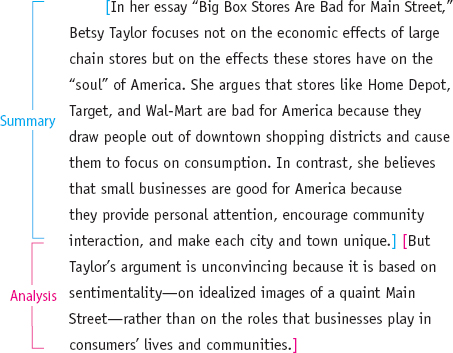A1-d: Analyzing to demonstrate your critical thinking (written texts)
Whereas a summary most often answers the question of what a text says, an analysis looks at how a text conveys its main idea. As you read and reread a text—previewing, annotating, and conversing—you are forming a judgment of it. When you analyze a text, you say to readers: “Here’s my reading of this text. This is what the text means and why it matters.”
Balancing summary with analysis
If you have written a summary of a text, you may find it useful to refer to the main points of the summary as you write your analysis. Your readers may or may not be familiar with the text you are analyzing, so you need to summarize the text briefly to help readers understand the basis of your analysis. The following strategies will help you balance summary with analysis.
- Remember that readers are interested in your ideas about a text.
- Pose questions that lead to an interpretation or a judgment of a text rather than to a summary.
- Focus your analysis on the text’s thesis and main ideas or some prominent feature of the reading.
- Pay attention to your topic sentences to make sure they signal analysis.
- Ask reviewers to give you feedback: Do you summarize too much and need to analyze more?
Here is an example of how student writer Emilia Sanchez balances summary with analysis in her essay about Betsy Taylor’s article (see A1-a). Before stating her thesis, Sanchez summarizes the article’s purpose and central idea.

Drafting an analytical thesis statement
An effective thesis statement for analytical writing responds to a question about a text or tries to resolve a problem in the text. Remember that your thesis isn’t the same as the text’s thesis or main idea. Your thesis presents your judgment of the text’s argument.
If student writer Emilia Sanchez had started her analysis of “Big Box Stores Are Bad for Main Street” (see A1-a) with this thesis statement, she merely would have repeated the main idea of the article.
ineffective thesis statement
Big-box stores such as Wal-Mart and Home Depot promote consumerism by offering endless goods at low prices, but they do nothing to promote community.
Sanchez wrote the following thesis statement, which offers her judgment of Taylor’s argument.
effective thesis statement
By ignoring the complex economic relationship between large chain stores and their communities, Taylor incorrectly assumes that simply getting rid of big-box stores would have a positive effect on America’s communities.
MORE HELP IN YOUR HANDBOOK
As you draft your thesis, try asking what, why, and how questions to form a judgment about a text you are reading.
- What has the text’s author overlooked or failed to consider? Why does this matter?
- Why might a reasonable person draw a different set of conclusions about the subject matter?
- How does the text complicate or clarify something else you’ve been thinking about or reading about?